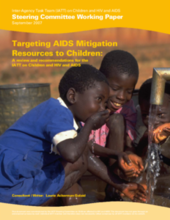The vulnerability of children varies as a result of many, interrelated factors, including age, gender, family care, poverty, disability, violence and food security among others. The AIDS epidemic increases children’s vulnerability in many tragic ways. A child’s vulnerability increases as a direct result of his or her own positive HIV status or because of the HIV infection, illness and death of a parent that results in loss of care, nurturing, income and other basic needs. Most often, the direct affects of AIDS create vulnerability both for the child and for the household. In high prevalence settings, children’s vulnerability also increases as a result of the indirect affects of AIDS. When teachers and health workers become ill and die, when caretakers become overburdened and when the general economy is weakened by the lack of productive labour, children, households and communities are made more vulnerable.
AIDS mitigation includes a broad range of interventions aimed at the protection, care and support of children made more vulnerable by AIDS. Included among these are efforts to ensure: fulfilment of basic needs, equitable access to basic services such as education and health care; alternative care for children without parents or family care; psycho-social interventions; and, legal protection from discrimination, exploitation, abuse, harmful labour and other rights violations.
Targeting AIDS mitigation resources to children is the process of identifying which children will receive the benefits of any given policy, programme or intervention. Targeting necessarily prioritizes certain children (or households or communities in which children are living) and directs the allocation of limited resources. The three major objectives in targeting are 1) that the assistance, services or support are received on the basis of need (i.e., vulnerability), 2) to avoid any harm that might result from targeting; and, 3) to ensure efficient and effective use of available resources.
Targeting AIDS mitigation resources to children takes place in the context of other development agendas and initiatives intended to benefit children, including the Convention on the Rights of the Child, Education for All, specific disease elimination and eradication efforts, elimination of the worst forms of child labour and many others. Special interest funds such as AIDS mitigation resources for children can create tension with and even detract from other, more universal initiatives and broader development goals. When especially abundant, these resources can warp the development agenda. Identifying approaches to targeting that enhance other development agendas while still achieving desired outcomes for children affected by AIDS is an ongoing challenge.

